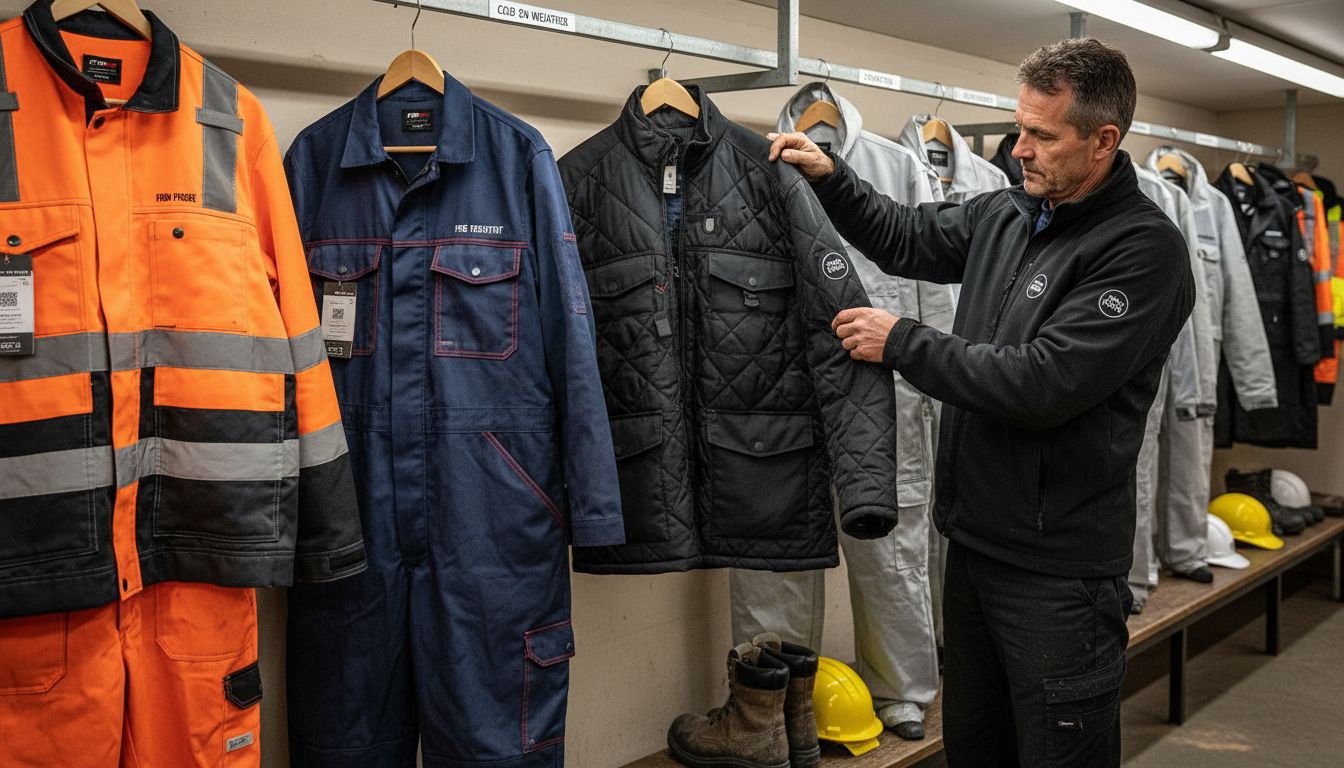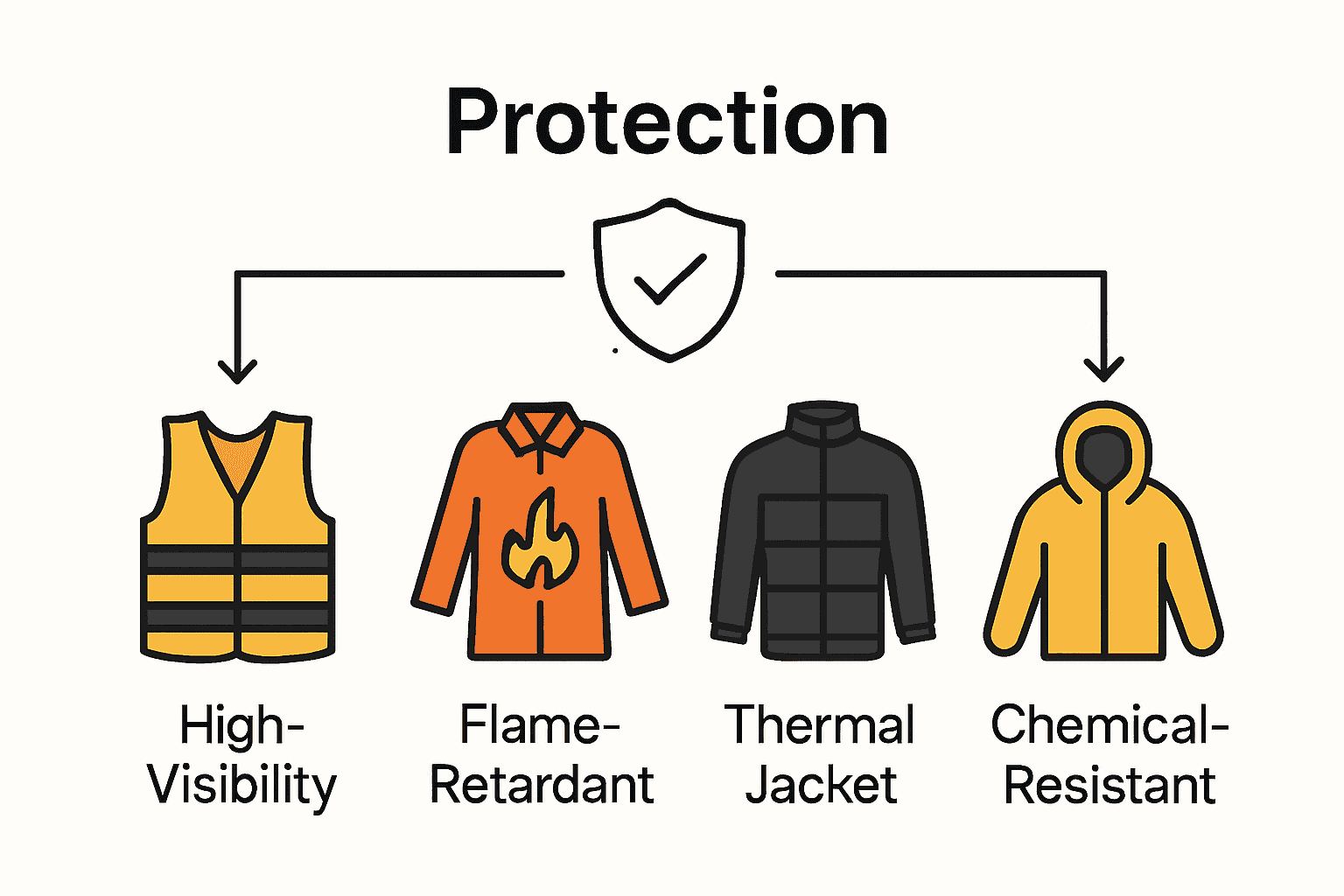Most people think any sturdy pair of jeans can handle a day at a job site, but construction workwear is a world apart. Over 80 percent of workplace injuries can be prevented with proper protective clothing, making these garments a vital safety system, not just an afterthought. Understanding the differences and importance of real work construction clothes can keep workers safer, more comfortable, and better prepared for the challenges they face every day.
Table of Contents
- Defining Work Construction Clothes And Misconceptions
- Types Of Construction Workwear And Key Differences
- Essential Features: Durability, Comfort, And Protection
- Safety Standards And Compliance In Workwear
- Caring For And Maintaining Work Construction Clothes
Key Takeaways
| Point | Details |
|---|---|
| Importance of Specialized Workwear | Construction workwear is essential for worker safety, providing protection against environmental hazards and meeting unique job requirements. |
| Types of Workwear | Various categories, including high-visibility, flame-retardant, thermal, and chemical-resistant wear, address specific safety needs. |
| Durability, Comfort, and Protection | Effective construction workwear must blend durability, comfort, and protective features to ensure worker efficiency and safety. |
| Maintenance Is Crucial | Proper care and maintenance of workwear extend its life and functionality, ensuring continued worker protection in hazardous environments. |
Defining Work Construction Clothes and Misconceptions
Construction workwear is far more than just clothing - it’s a critical safety system designed to protect workers in challenging environments. Work construction clothes represent specialized apparel engineered to shield professionals from potential workplace hazards while providing comfort and functionality during demanding physical labor.
According to research from fashionandtextiles, construction workwear must address complex challenges beyond basic clothing. The study highlights that effective work clothing must accommodate the unique motions and environmental stressors encountered in construction settings. Workers require garments that offer:
- Unrestricted movement during repetitive tasks
- Protection against environmental elements
- Durability under intense physical stress
- Compatibility with safety equipment
Common misconceptions about construction workwear often lead professionals to underestimate its importance. Many believe any sturdy clothing will suffice, but specialized workwear goes far beyond simple durability. These garments are meticulously designed with advanced materials, reinforced stress points, and ergonomic considerations that standard clothing cannot match.
 Understanding workwear for construction requires recognizing that these are precision-engineered protective systems, not just fabric and stitching.
Understanding workwear for construction requires recognizing that these are precision-engineered protective systems, not just fabric and stitching.
The right work construction clothes can mean the difference between comfort and constant distraction, between safety and potential injury. They’re not just about looking professional - they’re about creating a comprehensive personal protection strategy that allows workers to focus entirely on their complex and challenging tasks without being hindered by inappropriate clothing.
Types of Construction Workwear and Key Differences
Construction workwear is a complex ecosystem of specialized clothing designed to protect workers across diverse working environments and specialized trades. Understanding these variations is crucial for selecting the right protective gear that ensures both safety and performance.
According to mpsconstructionsupplies, construction workwear can be categorized primarily by trade and weather conditions. This comprehensive approach recognizes that different roles demand unique protective characteristics. The primary types of construction workwear include:
Here’s a comparison of the main types of construction workwear and their key protective features:
| Workwear Type | Key Protection Purpose | Typical Features |
|---|---|---|
| High-Visibility Clothing | Enhanced visibility in low-light | Reflective strips Bright colors |
| Flame-Retardant Gear | Protection from fire and heat | Fire-resistant materials Reinforced seams |
| Thermal Gear | Insulation in cold environments | Insulating fabrics Windproof layers |
| Chemical-Resistant Wear | Defense against chemical exposure | Sealed seams Specialized outer coatings |
- High-Visibility Clothing: Essential for workers in low-light environments
- Flame-Retardant Workwear: Critical for welders and workers near potential fire hazards
- Thermal Gear: Designed for extreme cold or outdoor work environments
- Chemical-Resistant Apparel: Necessary for specialized industrial and chemical work sites
Insideworkwear further elaborates that each workwear type is engineered with specific protective properties. For instance, high-visibility clothing isn’t just about bright colors - it incorporates reflective materials and strategic design to maximize worker visibility, potentially preventing serious accidents on active job sites.
The key differences between construction workwear types extend beyond mere appearance.
Weather resistance, durability, material flexibility, and specific trade requirements play pivotal roles in determining the most appropriate workwear. A welder’s protective gear will dramatically differ from a landscaper’s clothing, reflecting the nuanced needs of each professional environment. What Is Workwear? highlights that modern workwear is a sophisticated blend of safety technology, ergonomic design, and performance-oriented engineering.
Essential Features: Durability, Comfort, and Protection
Construction workwear is a complex performance system where durability, comfort, and protection aren’t just features - they’re lifelines for professionals working in challenging environments. These three critical elements determine not just the quality of clothing, but the potential safety and efficiency of workers across diverse trade sectors.
Durability stands as the foundational cornerstone of effective workwear. What Durable Work Clothing Means for a Working Man emphasizes that true durability goes beyond simple fabric strength. It encompasses:
- Resistance to abrasion and tear
- Ability to withstand repeated washing
- Maintaining structural integrity under physical stress
- Resilience against workplace chemicals and environmental challenges
Comfort and protection are intrinsically linked in high-performance workwear. Professionals require clothing that moves with their body, providing unrestricted motion while simultaneously creating a protective barrier against potential hazards. This means intelligent design that balances lightweight materials with strategic reinforcement, breathable fabrics that prevent overheating, and ergonomic cuts that reduce fatigue during long work shifts.
Protection isn’t a one-size-fits-all concept. Different trades demand specialized protective features - from flame-resistant materials for welders to high-visibility clothing for construction workers in low-light environments. The ultimate goal is creating workwear that acts as a second skin: responsive, protective, and so comfortable that workers barely notice they’re wearing specialized gear.
Safety Standards and Compliance in Workwear
Safety standards in construction workwear are not just bureaucratic checkboxes - they’re critical lifelines that protect workers from potential workplace hazards. Compliance represents a comprehensive approach to minimizing risks and ensuring worker protection across diverse and challenging work environments.
According to Wikipedia’s entry on high-visibility clothing, safety standards like ANSI/ISEA 107 in the United States provide critical guidelines for protective workwear. These standards categorize garments into specific classes based on exposure risk levels, ensuring that workers have appropriate protection for their specific working conditions. The classification system includes:
- Class 1: Low-risk environments with slower-moving vehicles
- Class 2: Moderate-risk areas requiring enhanced visibility
- Class 3: High-risk environments with complex background conditions
Understanding Safety Regulations in Construction highlights that compliance extends beyond simple visibility. Chemical protective clothing standards, as detailed in Wikipedia’s chemical protective clothing entry, underscore the complexity of workwear safety. These standards mandate rigorous testing for material performance, focusing on preventing chemical penetration, permeation, and potential fabric degradation.
Ultimately, safety standards are about more than regulatory compliance - they’re about creating a protective ecosystem that allows workers to focus on their tasks without compromising their personal safety. From flame-resistant materials to ergonomically designed protective gear, modern workwear represents a sophisticated intersection of engineering, material science, and human-centric design.
Caring for and Maintaining Work Construction Clothes
Maintaining work construction clothes isn’t just about appearance - it’s a critical strategy for preserving safety, functionality, and long-term performance of essential protective gear. Proper care extends the life of your workwear, ensures continued protection, and ultimately saves money by reducing frequent replacement needs.
Research from fashionandtextiles emphasizes the importance of adaptive clothing maintenance, particularly for garments that must perform across different seasonal conditions. Effective maintenance involves:
- Cleaning according to specific fabric requirements
- Inspecting for wear and potential structural damage
- Storing appropriately to maintain material integrity
- Addressing repairs promptly to prevent further degradation
How to Choose the Best Blue Collar Worker Apparel suggests developing a systematic approach to workwear maintenance. This means understanding the specific care instructions for different materials - flame-resistant fabrics, high-visibility garments, and chemical-resistant clothing each require unique cleaning and preservation techniques.
The ultimate goal of maintenance is preserving the protective capabilities of your workwear. Regular inspection, careful cleaning, and proactive repair aren’t just maintenance tasks - they’re critical safety protocols that protect you in challenging work environments. Treat your work construction clothes like the sophisticated safety equipment they are: with respect, attention, and consistent care.
Gear Up with Durable Work Construction Clothes Built for Your Toughest Days
When your work demands durability, safety, and comfort, you need gear that goes beyond ordinary. This guide reveals the importance of specialized construction workwear that protects you while offering lasting strength and flexibility—no compromises. If you understand the value of durable fabrics, ergonomic design, and protective features for long shifts under any conditions, then it is time to upgrade your wardrobe.

Explore our collection of Blue-Collar Working Man Sweatshirt Hoodies designed with the rugged worker in mind. Each piece combines quality materials and thoughtful construction to keep you safe and comfortable on the job. Don’t settle for less when you can wear workwear that embodies strength and resilience. Visit WorkWearComfort.com today and take the first step toward gear that works as hard as you do. Your next level of work construction clothes is just a click away.
Frequently Asked Questions
What are construction work construction clothes?
Construction work construction clothes are specialized apparel designed to protect workers from potential hazards in challenging environments while offering comfort and functionality for demanding physical tasks.
What are the key features to look for in work construction clothes?
When selecting construction work clothes, look for durability, comfort, protection, and compatibility with safety equipment. Features such as reinforced seams, moisture-wicking fabrics, and ergonomic design are also important.
How do I maintain my work construction clothes to ensure their effectiveness?
To maintain work construction clothes, clean them according to specific fabric requirements, inspect for wear, store them properly, and address repairs promptly. Proper care helps preserve protective capabilities and extends the life of the clothing.
What types of construction workwear are available, and what are their differences?
Construction workwear includes high-visibility clothing, flame-retardant gear, thermal wear, and chemical-resistant apparel. Each type serves a unique purpose, such as enhancing visibility, providing thermal insulation, or protecting against chemical exposure.

Recommended
- Ladies Construction Workwear: Complete Guide for 2024 – WorkWearComfort
- Understanding Workwear for Construction: Key Insights – WorkWearComfort
- Electrician Work Clothes: Complete Guide for 2024 – WorkWearComfort
- 7 Essential Tips for Choosing the Best Construction Hoodie – WorkWearComfort
- what to wear with cowboy boots men | Coveti


